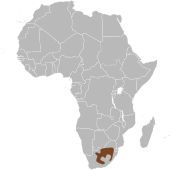White tailed wildebeest
| White tailed wildebeest | ||||||||||||
|---|---|---|---|---|---|---|---|---|---|---|---|---|

The white tail allows it to be distinguished from the blue wildebeest , which has a black tail. |
||||||||||||
| Systematics | ||||||||||||
|
||||||||||||
| Scientific name | ||||||||||||
| Connochaetes gnou | ||||||||||||
| ( Zimmermann , 1780) |
The white-tailed wildebeest ( Connochaetes gnou ) is an African antelope belonging to the genus of the wildebeest . It occurs exclusively in southern Africa , making it the most common wildebeest species in the south of the African continent.
The white-tailed wildebeest was once very numerous, but by the end of the 19th century the numbers had declined dramatically. Farmers began protecting the few remaining white tailed wildebeest on their land. In 1971, 3,100 individuals were again living in nature reserves and on private property. At the beginning of the 21st century the number was again more than 20,000 individuals.
Appearance
With a shoulder height of up to 114 centimeters, the white-tailed wildebeest is significantly smaller than the blue wildebeest . It can weigh up to 160 kilograms. The horns are up to 67 centimeters long.
The white-tailed wildebeest has a whitish “ponytail” and a black coat. The face is covered with bristle-like, protruding tufts, and long hairs grow on the neck and between the forelegs. From the neck to the shoulders there is a white mane with black tips. Both sexes have horns that are hooked upwards and forwards and thicken into a kind of "helmet" in the male.
Way of life
White-tailed wildebeests are grass-eaters who occasionally eat leaves. The habitat is the open savannah .
Due to the sharp decline in the population that began in the 19th century, the white-tailed wildebeest is one of the species whose way of life has never been studied under completely natural living conditions. It is only known that they migrated in large herd groups in their natural range, the climatically moderate South African highveld . The current stock, however, no longer migrates. Territorial males occupy territories, non-territorial males live in herds, but are kept away from the cows by the territorial males. The cows move with the calves through the bulls' territories in herds. In regions with a low population of white tailed wildebeest, the bulls are about a kilometer apart. In contrast, the minimum distance between the territories in regions with a high population of white-tailed wildebeest is around 180 meters.
The sociable animals are active during the day, but they rest in the midday heat. Most calves are born in summer. In the past, huge herds could be observed, with the now exterminated quagga joining the wildebeest.
literature
- Richard D. Estes: The Gnu's World: Serengeti Wildebeest Ecology and Life History. University of California Press, Berkeley 2014, ISBN 978-0-520-27319-1 .
- Clive A. Spinage: The Natural History of Antelopes. Croom Helm, London 1986, ISBN 0-7099-4441-1 .
Web links
- Connochaetes gnou inthe IUCN 2013 Red List of Threatened Species . Listed by: IUCN SSC Antelope Specialist Group, 2008. Retrieved September 5, 2013.

